Two news items that you probably will not hear about:
GAZA CITY (Ma’an) — Amid widespread protests Thursday night regarding the electricity crisis in the Gaza Strip, reports have emerged of Hamas security forces assaulting journalists covering the protests, as well as temporarily detaining an opposition leader in the besieged enclave.
Crowded marches had set off in the northern Gaza Strip, mainly in the Jabaliya refugee camp, demanding a solution to the power crisis which has left the besieged coastal enclave with less than half of the electricity it needs.
Witnesses told Ma’an that during the marches, Gaza security forces opened fire in the air to suppress protesters “to prevent protesters from reaching the electricity company in Jabaliya.”
https://www.maannews.com/Content.aspx?id=774899
BIL’IN, WEST BANK
Email from Iyad Burnat:
I am in the hospital with my son Abdul Khalik after the IOF [Israeli Occupation Forces] shot him in his head by rubber coated steel bullet at Bil’in demo today . We still in the hospital the doctor said today he will be more days in the hospital . The bullet caused the destruction of a simple skull and slight bleeding which affected his right hand
Pray for him.
I cannot find any news reports on this incident, but a graphic video is posted on YouTube and I recognize some of the farmers and family I joined for lunch yesterday.
https://www.youtube.com/watch?v=nEz29xxrQx4
I do not know if I could keep my deep commitment to nonviolence if the Israelis were shooting my children. How do people stay nonviolent in such a violent world?
I awaken in an apartment in Al Bireh just outside of Ramallah and a frosty dense fog surrounds the building. The kitchen window looks out on a beautiful hill that is usually topped by the Jewish settlement of Pisagot with a bypass road at the base, but this magical morning, the settlement is enveloped in fog and has virtually disappeared. For a pre-coffee moment I think, perhaps the settlers have gone home and the two state solution is really possible, but then the sun comes out and shines on blunt reality.
We are heading south on route 60 to Hebron, the largest city in the West Bank, in a service past the traffic hell of Kalandia checkpoint and rural villages, donkeys, innumerable Jewish settlements, barbed wire fencing with tall watch towers, lush invasive Jewish National Fund forests, and concrete walls to the left and the right. We see a police action with a cluster of Palestinian men, IDF soldiers overlooking a cliff above the road, pass a military base and many Bedouin villages with more trucks than camels, and tenacious olive groves hugging the terraced landscape. The highway is filled with twists and hairpin turns, ups and downs, and the driver is racing at top speed. We are tossed back and forth as he flies around the corners and I work on accepting my fate and clutching my seatbelt. Insha’allah takes on a whole new meaning. I see a huge USAID sign: “This project is a gift from the American people to the Palestinian people,” and I wonder if gifts like this are improving road conditions for Palestinians or making apartheid roads official or maybe a bit of both. On the other hand, at least USAID thinks there is a Palestinian people, as opposed to folks like Golda Meir and the history deniers who followed her.
Of the five checkpoints, only two are manned, but the soldiers seem busy chatting and do not stop us. We fly past mountains of junked cars, the fanatical settlement of Qiryat Araba, and finally reach the Old City of Hebron. We are staying in the Lamar Hotel, a project of the Hebron Rehabilitation Committee, a semi-governmental organization that attempts to maintain the cultural heritage in the Old City, renovating infrastructure, encouraging the Palestinian presence by developing economic activity.
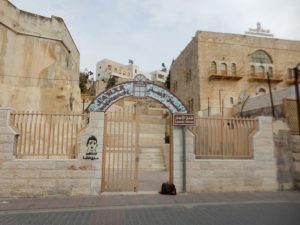
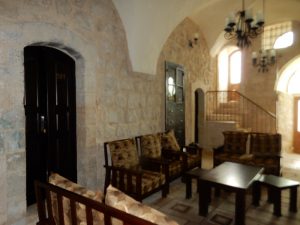 They also provide Palestinian residents who persevere in the Old City, despite the aggressive Jewish settlers and military forces that protect them, with electricity, water, and health care, although some are still leaving as life is so impossible. The hotel is a renovated, abandoned, once elegant Palestinian home with thick white stone walls, high ceilings, graceful arches and not quite enough hot water.
They also provide Palestinian residents who persevere in the Old City, despite the aggressive Jewish settlers and military forces that protect them, with electricity, water, and health care, although some are still leaving as life is so impossible. The hotel is a renovated, abandoned, once elegant Palestinian home with thick white stone walls, high ceilings, graceful arches and not quite enough hot water.
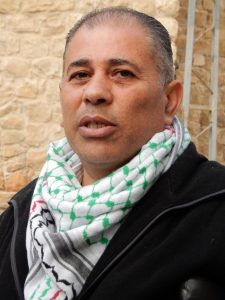 Hisham Sharabati is an activist and journalist who works with Al Haq, an NGO founded in 1979 to protect Palestinian human rights and the rule of law. He also manages the hotel and meets us for a tour. He is limping and using crutches after recent surgery to correct a leg injury years ago when he was shot by Israeli forces. We start by climbing up to the roof for an expansive view of the city of Hebron, the largest city in Palestine. Hisham begins to decipher the sea of cream to grey white buildings, the occasional Israeli flag, minaret, a swath of green olive trees, and a large Muslim cemetery, and once again I am plunged into the horror of aggressive, racist settlers and the soldiers who dominate the alternative universe which is Hebron and the desperately oppressed Palestinians who have the misfortune of being their neighbors.
Hisham Sharabati is an activist and journalist who works with Al Haq, an NGO founded in 1979 to protect Palestinian human rights and the rule of law. He also manages the hotel and meets us for a tour. He is limping and using crutches after recent surgery to correct a leg injury years ago when he was shot by Israeli forces. We start by climbing up to the roof for an expansive view of the city of Hebron, the largest city in Palestine. Hisham begins to decipher the sea of cream to grey white buildings, the occasional Israeli flag, minaret, a swath of green olive trees, and a large Muslim cemetery, and once again I am plunged into the horror of aggressive, racist settlers and the soldiers who dominate the alternative universe which is Hebron and the desperately oppressed Palestinians who have the misfortune of being their neighbors.
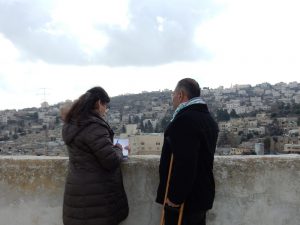
This is a brief summary as I struggle to wrap my brain around a flood of overwhelming, outrageous information. We see a large Israeli flag over a building in Tel Rumeida, the site of the first settler enclave.

This building has 16 apartments and was constructed in 2002 despite the area being an archaeological site with restrictions on new building. Palestinians in the area are not allowed to build and thus have only been expanding vertically to accommodate growing families. In November 2015, the IDF declared Tel Rumeida a closed military zone; if a Palestinian has permanent status in the area (residency or business) he or she can stay. But, for instance, if the Palestinian’s daughter marries and lives elsewhere, she is no longer allowed to visit her parents. Friends of Palestinians are obviously forbidden. Jewish settlers, on the other hand, can have visitors any time, and indeed thousands come during Jewish holidays. Internationals like the International Solidarity Movement (ISM) had an apartment in the area which was raided by the army and the activists were expelled, leaving a virtual no man’s land without non-Zionist eyes and ears, without the press or NGOs. Hisham explains, “This is committing a crime without a witness.”
He recalls the extrajudicial assassination that happened in 2016, an Israeli soldier shot a wounded Palestinian. Hisham heard the shooting and was able to interview and film the guy who filmed the killing and to collect testimonials. The soldiers claimed that Abd Al-Fattah Yousri Al-Sharif and Ramzi ‘Aziz Al-Qasrawi were attempting to carry out a stabbing attack against a soldier in the old city of Hebron. Al-Sharif was running, holding a pocket knife, after stabbing a soldier and slightly injuring him. He was shot twice from a distance of 10 meters and fell to the ground. The same soldier then shot Qasrawi in the head from a distance of three and a half meters as he lay bleeding on the ground from a previous bullet.
According to the report by Al Haq:
Four ambulances arrived to the scene and provided medical assistance to the injured soldier but not to Abd Al-Fattah or Ramzi who were both bleeding heavily. Settlers arrived to the scene, called Abd Al-Fattah and Ramzi “dogs” and “terrorists” and pointed out to the soldiers that Abd Al-Fattah was still alive. A soldier then shot at Abd Al-Fattah’s head from a distance of approximately three metres. The soldier had spoken to a higher rank officer before he shot Abd Al-Fattah. (Al-Haq affidavit no. 213/2016) https://www.alhaq.org/documentation/weekly-focuses/1037-the-killing-of-al-sharif-and-al-qasrawi-in-hebron
According to eye witnesses, only one of the killings was captured on video and received some international attention, but both men were shot while lying on the ground bleeding and posing no threat to the soldiers. This is what passes for normal behavior around here.
And then there are all the personal assaults and restrictions of movement that Palestinians face. In the Old Quarter, 520 Palestinian shops have been closed by military order since the Second Intifada, their metal doors welded shut, around 800 have closed due to lack of customers (who would shop in a closed military zone?) and local residents are frequently stopped by Israeli soldiers, despite protests Palestinian women are reportedly frisked by men, and all residents who must register for special permits to negotiate the 18 military checkpoints, are subjected to repeated body searches. There is another Jewish settlement called Beit Haddassah and the stairs opposite the building provide a short cut for many Palestinian residents going to school or home. Now there is a gate on the stairs which is open in the morning and afternoon for the school children, but people who live in the area have to travel all around the city and through olive groves to get from one point to the next.
For over fifteen years, the IDF has tried to issue permits to the local Palestinian residents. Because they refused, in late 2015, there were massive home raids and a “census” of sorts was created, the Palestinian ID’s were marked, “so people became numbers.” Now at each checkpoint, the soldiers check their census registry and decide who gets to pass. Frequently local residents are told they are not registered and then they are shut out from their businesses or homes and they wait on the street, hoping the next shift of Israeli soldiers will allow them to enter. Fifteen families have left in the past year; they couldn’t stand these conditions any longer.
Because their homes were empty, Jewish settlers tried to break in and occupy them. Al Haq took the break-ins to the courts and recently won the case, but the settlers are still occupying the homes. They are counter suing using an old Ottoman law that states inhabitants who do renovations then have a priority for the right of purchase. Ethnic cleansing one house at a time. During the olive harvest, these same lovely settlers steal the olives from the local Palestinians. The District Coordinating Office (DCO) determines which days the Palestinians are allowed to harvest their own olives. This year went smoothly except for the stoning of Spanish volunteers and the family of Hashem Azza (who died earlier of all the complications of living here. The final blow was tear gas inhalation.)
The famous covered market is behind Beit Haddassah where Palestinians are forced to cover the souq with chicken wiring and sheets of metal because the settlers throw garbage and excrement on them.
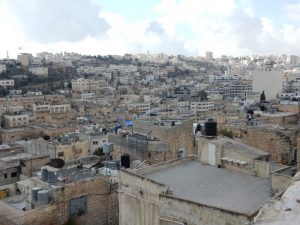

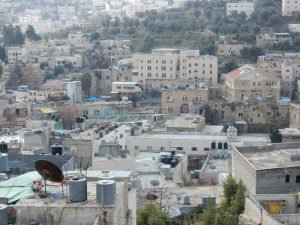
We see soldiers on roofs and Hisham explains that there are three military authorities here: The IDF who have no jurisdiction over the settlers, often agree with their egregious behavior, and just stand by while Palestinians are harassed and attacked. As soon as a Palestinian resists, the soldiers move in to arrest him for attacking the settler. The Blue Police and the semi-military Border Police have jurisdiction over the settlers, but their presence is minimal in Hebron. Functionally the IDF are everywhere protecting the Jewish settlers doing their criminal activities. Theoretically the majority of Hebron is H-1 and under Palestinian control, and the Old City and surrounding area is H-2 under Israeli control, but that is of course theoretically.
Hebron is a city drowning in the tears of a history that dates back to Abraham and Sarah. Hisham explains that in the last century it was a Muslim/Jewish city. In 1929 after Zionist immigration (ie the folks who decided that Palestine was not to be shared), there were the famous riots here where 67 Jews were killed. What is never mentioned is that 59 of these folks were Zionists and not locals and that more than 100 Palestinians were killed as well. After that catastrophe, the British (in their colonial wisdom) evacuated all the Jews and the buildings remained empty until settlers arrived in 1968 for Passover and refused to leave. Ever.
After various deals and negotiations and living in military bases, Kiryat Arba was established, (we can see the metal towers, military intelligence units located right up against Palestinian homes) and the settlement has been expanding ever since. In the 1980s, Palestinians were kicked out of the central bus station area for “military use” and obviously the placement of another Jewish settlement. In the past three months, more settlements have been approved, so the process of expulsion and ethnic cleansing has been moving along rather nicely if you think that God gave this to you and everyone else can go to hell. There are now even two military bases in H-1, the area that is supposed to be under Palestinian control. We can see the guard towers, concrete wall, and base up the hill just behind us.
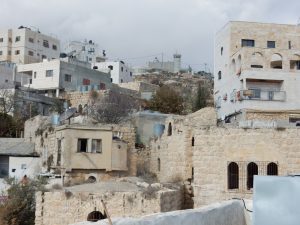
And then there is Shuhadeh Street, formerly a major market area, which we can see from the roof. Of 1,300 meters Palestinians cannot use 900 meters of the street and there are a host of residency and age restrictions (no young to middle age males) as well. And then there are twelve kilometers of streets that Palestinians can walk on but not drive. So think about this: you are elderly with severe arthritis, young and having severe abdominal pain, extremely late for an appointment, carrying home a ton of groceries or maybe a new couch…. And you cannot drive down the street where you live?
Hisham points out more settlements than I can keep track of and talks of the ultimate plan: A Jewish Hebron. The settlements are all growing and will link up with one of the most fanatical settlements of all, Kiryat Arba. Active and passive transfer. We see the latest graffiti: “Free Israel.” Apparently the ancient Jewish/Muslim city of Hebron needs to be freed of its indigenous population who are actually the intruders. History turned upside down. We spot a mobile cafeteria driving up the hill, “My brothers coffee shop,” an internationally funded settler run truck that distributes food and coffee free to the lovely Jewish soldiers who make this all possible. Hisham has been involved in a campaign to “Free Shuhadeh Street” which has been renamed: “Dismantle the ghetto: take the settlers out of Hebron.” Freed from the European ghettos, the settlers move to the Land of Israel where they create their own ghettos and ghettoize others. God’s plan.
Hisham recounts a mindboggling list of ongoing humiliations and aggressions. During a march in 2012 protesting the conditions in Hebron, mourners appeared carrying a coffin. The demonstrators separated, respectfully giving the funeral space to pass, but the IDF sprayed the mourners with teargas and skunk water forcing them to drop the coffin and run for cover. Who approves of such actions? The skunk water is an awful smelling concoction that is difficult to remove and made in the USA.
He shares a bit of very old history as we leave the hotel and drive towards the area around the Ibrahimi Mosque. A zillion years ago Abraham left Iraq, (does that belong to the Jews as well?) and came to Hebron. He bought a cave for a burial site. “So who did he buy it from? He bought it from me. Arabs and Canaanites. My blood is a mix of all the invaders.” He suggests that Abraham had two sons, Ishamel and Isaac, and their descendants should have equal rights. The tomb was a cave where Abraham, Sarah, and some of their descendants are buried and the mosque and synagogue are built upon that historic site.
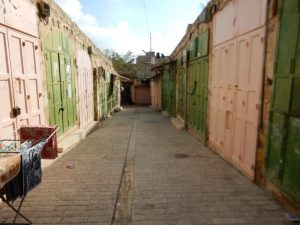
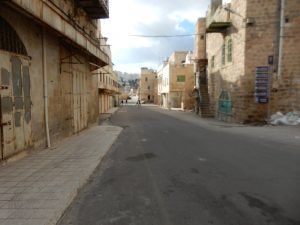
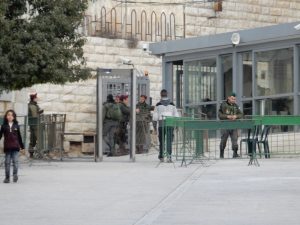
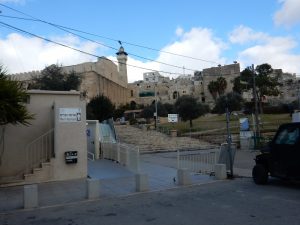
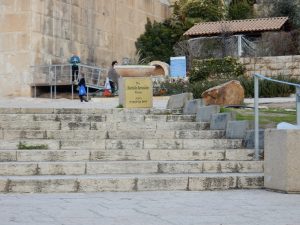 We wander through a virtual ghost city and end up at the Ibrahimi mosque/synogague, passing through two turnstiles and a clutch of armed soldiers who seem bored and distracted. Hisham explains they had “a busy morning.” Because there is a Moslem entrance (for Palestinians and tourists who are not Jewish) and a Jewish entrance (for Israeli Jews and tourists who are not Muslims), he tells us, if asked, here we are Jewish, but over there we are Christian, then back to Jewish. I am trying to keep my fake identities straight when an aggressive IDF soldier barks, “Who are you?” and my husband and I obediently answer, “We are Christian.” I am hoping I got that right. Then we poof into Jews, climb up the endless stairs, and enter the synagogue area which is a collection of rooms filled with books and Judaica and Torahs. It is hard to imagine the amount of blood that has been shed to retain control of this. But then again, the whole experience just confirms my devout atheism.
We wander through a virtual ghost city and end up at the Ibrahimi mosque/synogague, passing through two turnstiles and a clutch of armed soldiers who seem bored and distracted. Hisham explains they had “a busy morning.” Because there is a Moslem entrance (for Palestinians and tourists who are not Jewish) and a Jewish entrance (for Israeli Jews and tourists who are not Muslims), he tells us, if asked, here we are Jewish, but over there we are Christian, then back to Jewish. I am trying to keep my fake identities straight when an aggressive IDF soldier barks, “Who are you?” and my husband and I obediently answer, “We are Christian.” I am hoping I got that right. Then we poof into Jews, climb up the endless stairs, and enter the synagogue area which is a collection of rooms filled with books and Judaica and Torahs. It is hard to imagine the amount of blood that has been shed to retain control of this. But then again, the whole experience just confirms my devout atheism.
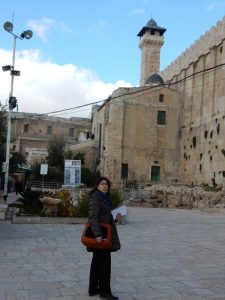
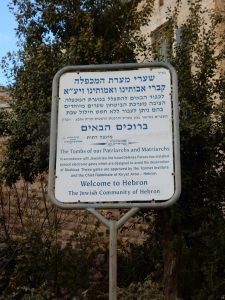
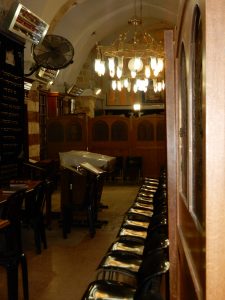
After our military dance with religion, we wander again, visiting the pottery shop in front of the mosque/synagogue, one of the oldest in Hebron, the room warm from the kiln, the Palestinian owner one of the few allowed to be there. There are Jewish only Arab-rein streets that allow the local and Kiryat Arba settlers to get to the synagogue without seeing “the other”, Stars of David spray painted on metal shop doors (evoking Swastikas painted on the shops of people we know and love), white lines painted on the street where 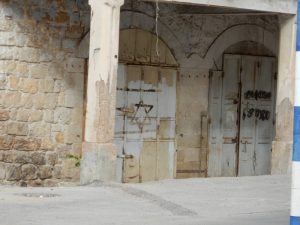
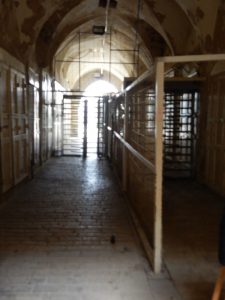 Palestinians are stopped for inspection and 15-30 year olds are frequently forbidden to pass. There are clusters of heavily armed soldiers, men in shorts and kippot jogging the streets, a little girl thinks we are settlers and grabs her sister and clutches her mother’s hand, clearly terrified.
Palestinians are stopped for inspection and 15-30 year olds are frequently forbidden to pass. There are clusters of heavily armed soldiers, men in shorts and kippot jogging the streets, a little girl thinks we are settlers and grabs her sister and clutches her mother’s hand, clearly terrified.
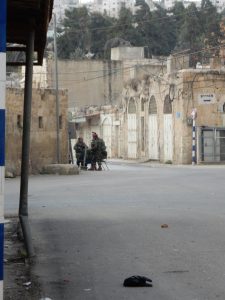

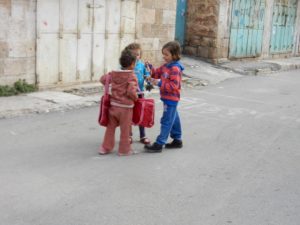 Palestinian homes and shops have windows covered in metal screens to stave off the damage from all the settler rock throwing. Palestinians painted a mural in front of a school dating back to the Ottoman era (1911), Jewish settlers painted over it and wrote, “Free Israel.” A playground was confiscated for a parking lot for tour buses, so the Palestinian children play in the detritus of the streets. When they go to school there is a checkpoint that is congested with kids in the morning, the kids get bored, some angry ten year old throws a stone, and then the children are tear gassed and sprayed with skunk water and gas. That could ruin your day and make you yearn for revenge, particularly if you are ten years old.
Palestinian homes and shops have windows covered in metal screens to stave off the damage from all the settler rock throwing. Palestinians painted a mural in front of a school dating back to the Ottoman era (1911), Jewish settlers painted over it and wrote, “Free Israel.” A playground was confiscated for a parking lot for tour buses, so the Palestinian children play in the detritus of the streets. When they go to school there is a checkpoint that is congested with kids in the morning, the kids get bored, some angry ten year old throws a stone, and then the children are tear gassed and sprayed with skunk water and gas. That could ruin your day and make you yearn for revenge, particularly if you are ten years old.

Hisham knows exactly where he can walk and where he is forbidden, though there are no signs, so Palestinians live in this kind of existential fear when they are in the Old City. He greets a smiling six year old girl near a new green “fence” separating a street leading to Kiryat Arba into Jewish and Arab sides. Her bicycle was confiscated when she scooted down the “wrong side.” The soldier grabbed her bike, stomped on it bending the frame, and tossed it into the bushes. How does a Palestinian mother explain this to her child?


We pass two disputed Palestinian houses occupied by settlers and now a closed military area, Beit Lea and Beit Rachel. Between them is a little house. During the three years of curfew (Second Intifada) children raced roof to roof to get to school. They would them gather at this little house, wait until the soldiers weren’t looking, then lower a ladder and run to school. The home owner was called “the Ladder Lady.” Sometimes this strategy worked and of course sometimes it didn’t.
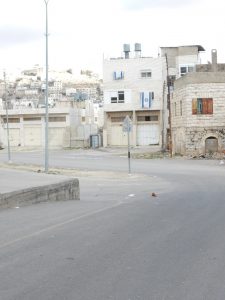
And that is a taste of Hebron where the dream of a Jewish Judea and Samaria is culminating in an explosion of racism, dispossession, provocation, and some kind of mass insanity grounded in a fundamentalist interpretation of Judaism and supported by the state in the name of the Jewish people. I am filled with horror and shame.


For more information from previous blogs:
https://alicerothchild.com/2015/10/in-memoriam-hashem-al-azza-october-29-2015/
https://alicerothchild.com/2014/06/and-for-extra-credit-hebron-part-two-june-20-2014/
https://alicerothchild.com/2012/10/oct-21-greetings-from-the-brownshirts-and-klansmen-of-hebron/